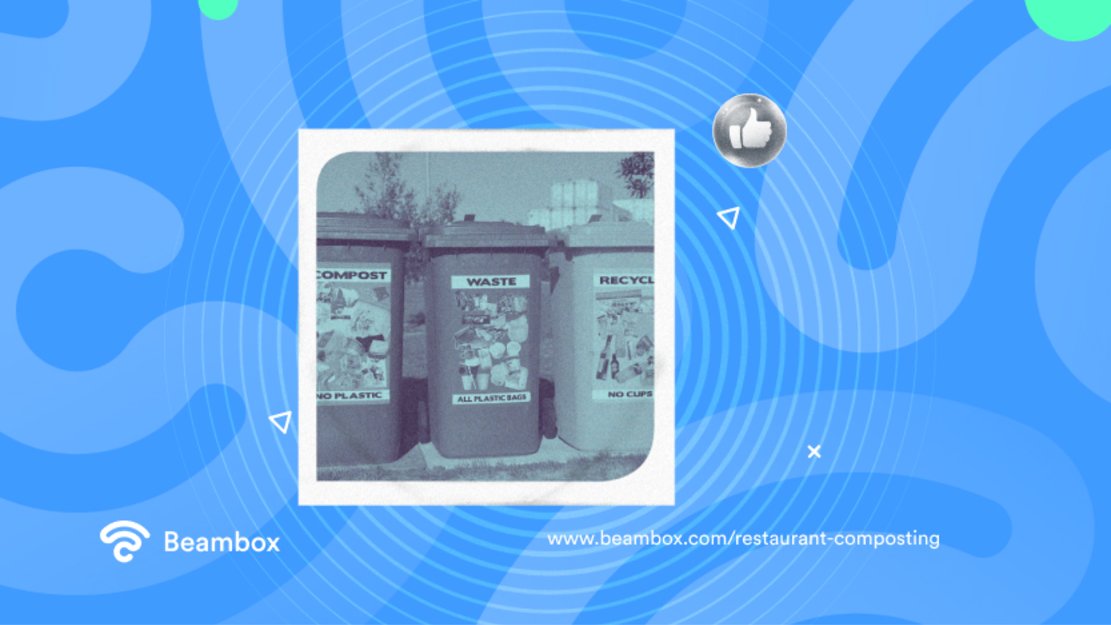Restaurant composting is a waste management method that gives way to sustainability for a better future. You must usefully contain your food waste if you have a food establishment.
Here, composting gives your restaurant’s environment a fresher and healthier outlook.
Moreover, composting restaurant waste has many benefits. If you are new to this area, you might need help launching composting. Therefore, this article will help you understand the basics and explore vital restaurant composting strategies.

Benefits of Greening the Plate: What Is Restaurant Composting?
First, let’s go back and understand the term composting. It is a process that breaks the components of food scraps. Typically, compost material is organic waste, such as leftover food, coffee filters, leaves, and other biodegradable products.
Using the concept of greening your plate and incorporating more sustainable food is essential for composting. The goal is to achieve healthy, fertilized soil to produce better crops. Composting is a fantastic practice to incorporate into your business if you practice farm-to-table.
According to research studies, 84% of the food served in restaurants goes into trash cans. Therefore, it’s important to revise your priorities in making an impact in an environmentally friendly world.
Moving onto the perks, restaurant composting has numerous benefits that extend beyond personal gain. It starts a cycle of ecological measures, so the decaying food material transforms and ends up on someone’s farm.
There are multiple ways to look at the bright side of greening your plate and composting restaurant waste. For instance, when you use a composting mechanism to produce fertilized soil, you don’t have to rely on chemical fertilizers.
Moreover, you can advertise the use of fresh organic products in your food and use them to stand out. How? By using the fertilizer to grow healthier crops instead of purchasing costly synthetic fertilizers.
Even if you’re not growing raw materials, you play your part in a green and healthy world. The rich, dark soil you make prevents the constant consumption of harmful chemicals. This aspect is something you want to communicate with your restaurant advertising. Last but not least, composting waste from your restaurant can help you save on the waste disposal budget.

All Things Are Not Green: Can You Compost Everything?
However, not every food in your restaurant is compostable. To learn which food suits an ecological campaign, you must understand the idea of biodegradable and nonbiodegradable food.
Composting requires a proper ratio of carbon and nitrogen. Biodegradable food like fruits and vegetables have enough supply of these elements for successful composting. You can recycle these items and return the nutrient soil to Earth quickly as their natural decomposition ability is better.
Moreover, fruits and vegetables have less complex decomposition. They have an organic origin, namely carbohydrates, proteins, and more water content.
Other compostable items are eggshells, coffee, tea bags, and basically anything you can feed to worms.
Alternatively, food options such as dairy products, oils, fats, and meat, have more complex decomposition. These products need a higher temperature for composting, which is unachievable in small restaurant composting systems.
Also, meat and dairy products have more nitrogen which creates an imbalance between the carbon and nitrogen required for composting.
Moreover, food production is responsible for 25% of the carbon footprint. Therefore, environmental enthusiasts are turning more towards vegan restaurant menu ideas than traditional animal food.

Should You Implement Restaurant Composting Yourself or Outsource it?
Now that you know what to compost, let’s talk about how to compost. Well, there are two main options for restaurant composting; either do it yourself or outsource it. Let’s discuss both to make the decision easier for you.
If you want to opt for composting by yourself, you can regulate the system according to your restaurant’s sustainability aims.
Consequently, it will help reduce the disposal cost and improve the credibility of your establishment. It can also provide you with an educational opportunity and local community engagement.
Moreover, you can trade the compost with local farmers and gardeners. However, it may cost you time and labor. Alternatively, if you want to outsource the organic waste, you can contact local compost crusader services. They help pick up the waste and manage it through commercial composting.
This way, you can avoid the strain of constant management that comes with composting at your site. However, compare both options’ cost and revenue and choose which is best for you. If you have a small restaurant, composting on your own can cost you more. Why?
Because of the small space, you’ll have to rent a proper site for composting. The continuous labor and dispatching of waste from restaurant to site will add extra expense. Moreover, you will need tools such as shovels and compost bins.
Therefore, keep your budget and the size of your business in mind before choosing the ultimate method for composting.
Layering It Up: How To Use Compost Bins for Restaurants?
Composting is a scientific method that requires certain environmental components to sustain. Therefore, you must know the requirements for composting restaurant waste before starting the process. The following steps will elaborate on how you can compost the materials by yourself.
- Composting bin: First, you need compost bins for restaurants to hold the compost materials. The good news is a plastic bin will do the work. Since the conventional process for small restaurant composting is aerobic, you may need to drill some holes in the bin. Nevertheless, a wooden container can also serve this purpose.
- Lining the composting bin: Now, line the composting bin with paper bags or liners. This trick will help to empty and clean the bin and drain the final compost.
- Fill the soil: Fill the lower portion of the bin with soil. Soil acts as a natural decomposer and brings microorganisms required for your restaurant’s organic recycling.
- Add Browns: Now fill a quarter of the total volume of the bin excluding the soil layer with browns. These are materials with more carbon content, such as papers, newspapers, dry leaves, and eggshells.
- Add Greens: Next, add a layer of greens. These are materials with more nitrogen content, such as fruits, vegetables, and coffee or tea residues. Keep adding green and brown layers alternatively until 75% of the bin’s total capacity is full.
- Maintenance: Keep the moisture and temperature of the compost in regulation. Ventilating the compost is also important because it improves the flow of oxygen for aerobic bacteria activity.
- Things to avoid: Do not add harsh chemicals, meat, bones, or pet waste to the bin. Also, keep the pest and odor in control by adding more dry browns.

Start Restaurant Composting the Right Way With These 5 Steps
After reading the general outline of restaurant composting, you can start your own setup. However, you will still need a guideline to ensure the success of the process.
Taking composting to a commercial level can be challenging. You might run into some troubles that can cause hurdles along the way.
Moreover, you might find the maintenance challenging or spend more on composting. Therefore, following the right steps will help you start composting restaurant waste effectively.
Step #1 for Restaurant Composting: Location of the Bins Can Make or Break It
Where to keep the bin in the restaurant is the first and most important question you need to consider. Restaurant composting within the property can cause many difficulties, such as unhealthy conveniences.
It can disrupt daily operations and cause unnecessary distractions. Therefore, keep the compost bin in places with less traffic.
Make sure the location of compost material is easily available to staff. Also, keep compost under optimal temperature conditions because cold weather can slow down the process.
Having a separate place within the restaurant location will work more effectively. However, make sure the compost area has a definite and short passage to the kitchen.
Moreover, placing compost bins near the kitchen is helpful for staff to dispose of vegetable and fruit peels. Remember, odor control must be your priority to ensure a healthy environment. Therefore, keep the bins in a room with proper ventilation.
Step #2 for Restaurant Composting: Training Isn’t Just for Business Operations
Choosing the perfect location isn’t enough because you need a deep understanding of the subject to launch restaurant composting. Composting is a scientific method that requires some practice. Therefore, training your staff is essential and will also transmit your company’s culture.
Your staff can reduce the chances of contamination and ensure a usable end product. Therefore, the first thing is to educate the team about the importance of the method. But how?
Firstly, initiate practice sessions if you plan on doing a moderate composting program and trading the product. Here, you have to tell your staff about the uses of compost and how it can provide a sustainable community.
Then proceed to train your staff about the materials they can compost. Prioritize telling about the distinction between the things you can and can’t compost. Moreover, give a clear guideline about browns and greens.
A single dish is a mixture of things. But as mentioned earlier, all materials aren’t compostable. Therefore, tell them about the separation of items for post-consumer composting.
It means the materials with a mix of used products, such as leftover chicken salads. Separation of material is a significant step because it helps prevent contamination.
Also, give guidelines on how to fill the compost bin. Your staff must know about the compost material’s temperature, moisture, and oxygen balance. Adhering to proper training will help ensure plenty of compost by the end.
Step #3 for Restaurant Composting: Let the World Know About It
Pairing restaurant composting with community engagement will impact your business and environment equally. If you are initiating a compost program, spread the word.
Letting people know will improve your ground support as a sustainable food establishment and draw health enthusiasts. There are many ways to gain attention toward your composting facility. Let’s discuss them below.
Firstly, you can advertise your program to get volunteer staff for a starting period. You can also add signage on your restaurant premises and insert the word in your menu.
Secondly, if your community knows about your efforts, you can sell the fertilized soil and generate revenue. However, occasionally donating to farms can also be beneficial to stand out as a generous establishment. Moreover, telling your consumers about the program will create a thoughtful approach and prevent them from wasting food.

Step #4 for Restaurant Composting: Don’t Place the Bins To Forget About Them
While having a separate area for restaurant composting is an option, don’t forget to monitor it. Compost is something that needs a proper checkup once or twice a week. Moreover, you must turn over the compost to mix the components and help natural reactions thrive.
If you are not monitoring your compost facility, you will not know if the process is going right. Sometimes, the compost gets pests and attains more moisture than usual. Therefore, looking over will prevent major disasters that can ruin the compost.
Additionally, you can only address contamination if you know it’s happening firsthand. Analyzing at regular intervals and reassessing the facility is the only way to ensure the process is productive.
Making Other Changes Is Also Necessary: Use Compostable Restaurant Supplies
Lastly, let’s reveal the truth about waste management. Restaurant composting is not just about managing food waste. You should also add compostable restaurant supplies to the list.
If you want a more environmental and sustainable handle in your restaurant, go for bioplastic. From palm leaf trays to composting napkins, you can use anything biodegradable. But what’s the need for this?
Traditional plastic isn’t compostable. So ditching it for bioplastic will leave less to waste and more to utilize. All kinds of sustainable things are available now, such as compostable cups, straws, bowls, coffee filters, and containers.
Choosing these products will reduce the waste production of your restaurant, which in turn will reduce the trash pickup cost. Apart from compostable utensils, you can also use boxes, bags, and packaging made with biodegradable plastic.
Moreover, this choice will appeal to all customers who care about the environment. Therefore, communicate this choice and the reasoning behind in your marketing campaigns.
Don’t Start Restaurant Composting Without Applying These Tips
By now, you must have grasped how to implement composting techniques very easily. You can choose to do it yourself or use external services. Additionally, ensure your staff has enough knowledge about composting so everything runs smoothly. One sustainable step will start a chain of beneficial reactions useful for your restaurant, community, and environment.
If you want to scale up your marketing for your restaurant, check out Beambox. With Beambox WiFi marketing platform, you can automate your marketing campaigns and grow your online reputation.
Beambox has no hidden costs and requires no additional hardware. Start your free trial today!
Get Started With Free WiFi Marketing
Beambox helps businesses like yours grow with data capture, marketing automation and reputation management.
Sign up for 30 days free